
Sean Baker’s The Florida Project was inspired by news articles about the affordable housing crisis – the “hidden homeless” who are living in cheap motels week to week. The film is set in Orlando, FL, the home of Disney World, which provided the visual juxtaposition of poverty and fantasy.
Baker met his co-writer, Chris Bergoch, at NYU’s undergrad film school. They had been on a few projects together, including Starlet and Tangerine, but formally started to co-write in 2010. In fact, Bergoch had recommended the articles about Florida’s ‘hidden homeless.’ Baker is mostly interested in character-driven, true to life stories of any genre. “The films that I want to make, and have the most impact on me, are the ones that I feel human watching,” Baker continues, “ that make me think, get me in touch with my emotions, and make me want to get into a discussion with somebody else about the thing I just saw.”
The films and filmmakers who have influenced Baker have all “gotten me in touch with my emotions.” Hal Ashby’s Harold and Maude, Lars von Trier’s The Idiots, the films of George Romero and South Korean director Chang-dong Lee. But for The Florida Project, Baker looked to Francois Truffaut’s The 400 Blows, Ken Loach’s Kes, and episodes of The Little Rascals directed by Gus Meins and Robert McGowan, for the way they directed children. “They’re so underrated because they were so far ahead of their time in terms of comedy, and also child performances,” says Baker. “They were breaking the fourth wall back in the 1930s.”

Baker’s casting process was a little unorthodox. He had already cast the Florida native Brooklyn Prince as Mooney. They had put out the casting call to A-list actors, like Brittany Spears and Miley Cyrus, for the part of Halley, when Baker happened upon Bria Vinaite’s Instagram posts and videos. He was so drawn to her unique persona and energy, even though she had no acting experience, that he had her audition. What clinched it for Baker was how well Bria bonded immediately with Brooklynn. And finally, he cast Willem Dafoe as Bobby, the manager of the Magic Castle Motel.
Baker’s acting coach and partner, Samantha Quan was an invaluable addition to the team, especially with so many inexperienced actors in key roles. Initially, Quan was there to coach the kids, but when Baker told her he was casting Bria, she replied “You’re going to need me.” So Quan worked with the actors for the month of prep in Florida.
Bria Vinaite describes the rehearsal process, “Every day I had classes with the kids and by myself, going over every scene, breaking down my intent and emotions. I got to build a very close bond with Brooklynn.” Vinaite continues, “We did a lot of character development, and I made a backstory.” Baker arranged for her to “hang out” with three different moms who lived in the motels. “They were so open and welcoming and shared their day-to-day struggles. It was really helpful.”
Part of the plan for Baker was to prepare the actors to be comfortable enough in their characters to be able to improvise on set. Regarding rehearsals, “Bria would be put into scenarios where, yes she would learn her lines, but she would also be able to mix it up on set if I asked her to, because she was understanding her character so well, and she was understanding about listening. That’s a big part of acting; it’s about listening,” explains Baker. Vinaite had to be able to “hold her own with Willem Dafoe in about six weeks,” so the pressure was on.
The approach to rehearsing with the kids was similar, says Baker. “We wanted it to be almost like a summer camp for them, for them to feel as if they’re always having fun doing what they’re doing.” Baker also garnered ideas from the kids that were incorporated into the script. He would ask them to give an impromptu tour of the Magic Castle. “So we would just follow them, as they’d give us a tour, to see their way of seeing it. We had scripted lines for them, but we would just ask them to do new things like that, as well.”
On set, Dafoe was incredibly devoted to the project and helpful to the other actors. Says Vinaite, “he treated all of us like we were equal. If I ever had any questions, or if I ever needed to talk, he was always there.” Vinaite describes the scene where she slams a pad on the Magic Castle office window and yells a Willem. “I was very nervous about that, because it’s just not something I would ever do.” But Dafoe recognized her fears and yelled at her in the scene. “He literally pulled it out of me. It was very helpful.”
One aspect of the script that changed was the scene with the DCF officers, after interviewing actual DCF officers to understand the process. Says Baker, “When we tried to put those scenes in the film, it became another movie. It’s “Law & Order” all of a sudden. So we realized that the audience really only has to know so much.” Baker continues, “For telling the story from the prospective of a child, we realized that all these details are not really that important to the core of the story.”
Baker would block the scene with cinematographer Alexis Zabe and the actors to figure out all the camera placements. The DCF scene was the most complicated to block. “I remember spending a good hour just telling everybody how they’re walking: ‘follow me, they’re walking this way, Bobby is walking down, DCF is walking up – this is where she falls on the steps.’ That was a big orchestration.”
Blocking the kids was quite different for Baker. “Kids this age have to come in with a real foundation, meaning they have to know their lines. You can’t just tell them to walk in and walk across the room. You have to say ‘OK, I want you to do exactly what I’m doing.’” Baker continues, “once they have the foundation, then they’re able to loosen it up a bit.”
For the scene in the pool between Halley (Bria Vinaite) and Ashley (Mela Murder), Baker wanted it to sound like a real conversation. They had scripted the scene, but he asked them to “talk about these things. You understand your characters enough now.” He continues, “I didn’t know they were going to give me a condensed 20 seconds where they perfectly covered everything I needed them to cover, because they got that place.”
They would also go off schedule and ‘grab’ impromptu scenes, when conditions presented themselves, like “Let’s grab that rainbow before it fades. Then, all of a sudden, every department has to scramble. But everyone seemed to adapt.” Another impromptu scene was when Willem had to shoe the flamingos away from the front office. When the flamingos showed up, the crew switched gears and quickly shot the unscripted scene.
Baker was always “thinking about the editing while shooting, because I’m the editor. I also knew that I couldn’t go back to do any pick-ups, because the kids were growing up. They even looked different a month after we shot.” The landscape and locations were also changing rapidly with new construction, so they would not be able to go back.
Baker talks about his collaboration with cinematographer Alexis Zabe, “Alexis is an incredible artist, and he’s such a wonderful person to work with, and has such an eye. The great thing about working with a DP you connect with is that there is the unspoken communication where you’re already on the same page about which lenses to use, the focus, the framing, and the camera movement.
“When you work with really creative collaborators, they bring so much to the table so it makes you look good,” Baker continues. “My sister (Stephonik Youth) was the Production Designer on the film. She worked closely with Alexis to figure out the color scheme, to use the existing elements to enhance them, or to get to a place where it’s not hyper-reality, but a degree above reality to put us in the state where we’re viewing this world through the senses of a child.”
Speaking about his experience directing The Florida Project, Baker reveals, “It was about communication for me, like learning my lesson that I had to be clear; and that takes more time. With a smaller crew with everyone wearing many hats, you don’t have to talk as much. But when you’re dealing with a 40 person crew and all these different departments, and if I haven’t worked with you before, you have to literally take the time to walk to every department to be like ‘This is what’s happening.’”
In the end, Sean Baker hopes that this film is “one step towards change, and motivates people to work with local organizations that are trying to develop affordable housing, or to at least think about it in a different way, removing the stigma, putting a human face on it, and becoming an advocate for change in general.”
Baker continues, “I think that we’re living in a day and age where we kind-of shut down, because there’s so much negativity out there. We’re being inundated with a politically divided country. There’s natural disasters, there’s tragedies and shootings happening all the time, and negativity on Twitter. We need moments where it’s about being human again.’





